The announcement of a rubber price stabilisation fund is yet to bring the desired cheer to plantations. The price of RSS-4 grade, which buoyed up to Rs 132 per kg from Rs 128 per kg initially, has slipped down this week to Rs 125 per kg.
The RSS-5 grade is sold at Rs 123 per kilo. At retail levels, the price is much lower.
Growers say that the main reason for the fall in prices, at this juncture, is the delay in procurement by tyre firms in the domestic market. Secondly, the international price of NR has been on a downward trend, driven by crude prices. China, perceived as a bulk consumer in the coming years, is yet to manifest its rubber demand appetite.
The Kerala government had earmarked Rs 300-crore price stabilisation fund to support the farmers, bogged down by the poor price realisation. The state promises to ensure at least Rs 150 per kg for the rubber farmer.
Under this scheme, any difference between the prevailing market price and Rs 150 per kg is transferred to the farmers’ bank account. The registration process to facilitate the money transfer has started.
At the same time, there are practical difficulties in this procedure, points out P K Abraham, a rubber farmer.
“One can register only in rubber processing co-operatives. If there is no rubber co-operative in my neighbourhood, there is no alternative system to provide me with the registration and price support facility,” he says.
At least two farmers had committed suicide in the last two months following the price crisis. Import of natural rubber had increased to 4 lakh tonnes in 2015. Centre has raised the import duty of natural rubber to 25% from 20% last month.
This intervention came too late and failed to stimulate domestic demand at the right time. The farmers refuse to replace the old and ailing trees in the plantations with new saplings. In the thick of monsoon, most rubber growers have been reluctant to invest in rain gear for the trees to facilitate tapping. As the price goes down, farmers’ lack of interest has taken latex production to its lowest levels.
Already, rubber output has dropped 11% in the first two months of the current fiscal. In 2014-2015, the year-on-year fall was 15% and in 2013-2014, this was 14%.
The gap between demand and supply of raw rubber was more than 3.6 lakh tonnes in the last fiscal. Automotive Tyre Manufacturers Association and All-India Rubber Industries Association have been complaining of the shrinking availability of rubber in domestic market.
– financialexpress.com


























